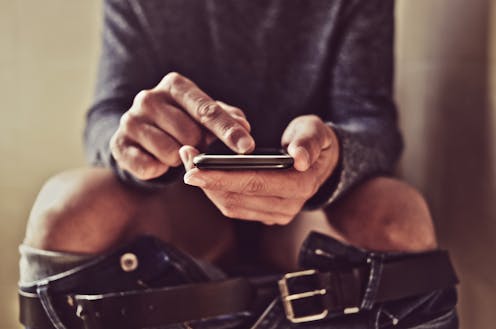Does it matter if you sit or stand to pee? And what about peeing in the shower?
- Written by Christian Moro, Associate Professor of Science & Medicine, Bond University

Do you sit or stand? That is the question about 7,000 men[1] around the world have been asked[2] about how they pee.
We’ll get to their answers soon. But the media interest[3] that followed prompted one urologist to recommend[4] some men sit to urinate, especially as they age.
What is the best way to urinate? Does that apply to women? We research the bladder[5] and lower urinary tract[6]. Here’s what the evidence says.
Read more: Health Check: what can your doctor tell from your urine?[7]
Do most men stand to pee?
The survey found men in different countries differ in how they pee.
In Germany, 40% of men report sitting while they pee every time, as do 25% of Australians. In the United States, it’s just 10%.
Some people even view standing to pee[8] as “superior” and sitting inferior. In German, the word Sitzpinkler[9] means someone who sits to pee; it can also be used as an insult.
But habits may be changing. In Australia, for instance, the survey found younger men are more likely to sit down than older men. Some 36% of younger men sit down most or every time, while only 20% of men aged 55 and older report doing so.
So should men stand or sit?
When it doesn’t matter
In general, the literature suggests it doesn’t matter[10] if a healthy man stands or sits when he pees.
Regardless of the position, there seems to be no difference in the time taken to pee, the flow rate, and how completely the bladder is emptied.
So long as there are no urinary concerns, men are free to choose their preferred position. If you chose to stand, just be sure to aim well.
Read more: Is urine sterile? Do urine 'therapies' work? Experts debunk common pee myths[11]
When it can
Recommendations for sitting or standing become less clear for men with lower urinary tract symptoms[12]. These include issues such as having poor stream (for example, a dribble rather than a steady flow of urine), straining while urinating or feeling the bladder has not completely emptied[13] after finishing.
For some of these men sitting[14] is preferred to help increase the flow and empty the bladder. Others find the same relief comes from standing.
For men with benign prostatic hyperplasia[15], otherwise known as an enlarged prostate, there is evidence standing[16] may help fully empty the bladder. But this advice may not work for all. That’s because how much the prostate has become enlarged, and the impact this has on urinary flow, can be different between people.
As standing or sitting can matter, for some men, it’s worth having a chat with your doctor about what’s best for you.
Read more: Do men really take longer to poo?[17]
How about women?
The structure of the female pelvic area is quite different to males, as it accommodates the vagina, uterus and reproductive structures. And the female anatomy is just not designed to pee standing up. So, making a habit of, say, peeing in the shower, is not advised.
Females do not have a prostate, which helps supports the male bladder while standing. This lack of support can place extra strain on the bladder region when not sitting down, making it harder for the bladder to fully empty.
The structure of the pelvic floor[19] muscles are also different in females. For females, it is particularly important to allow these muscles to fully relax to allow the urine to flow freely.
If the bladder doesn’t empty fully[20], it can lead to increased infections, bladder stones, and even impact kidney health in the long term.
Even with one leg up, the pelvic floor does not rest properly, so the bladder may not be able to fully empty. As such, sitting down is usually the best position to let these muscles relax.
Standing and “hovering” over the loo may keep these muscles slightly constricted, making it hard to fully empty the bladder. A contracted pelvic floor can also cause the urine to spray more than usual, which is why you might often find drops of urine on a toilet seat after someone before you has tried to hover over it.
How about peeing in the shower?
Peeing in the shower not only makes it harder for your muscles to relax, it can be unhygienic. It might also cause an association between water and urination, leading to issues where hearing water might make you need to rush to the bathroom.
So, for both males and females, peeing in the shower is a clear no-no.
If you or someone you know has bladder or bowel issues, the Continence Foundation of Australia has online resources[21] and a helpline[22] (1800 33 00 66).
References
- ^ 7,000 men (docs.cdn.yougov.com)
- ^ have been asked (today.yougov.com)
- ^ media interest (www.news.com.au)
- ^ to recommend (www.telegraph.co.uk)
- ^ bladder (www.tandfonline.com)
- ^ lower urinary tract (journals.physiology.org)
- ^ Health Check: what can your doctor tell from your urine? (theconversation.com)
- ^ standing to pee (www.bmj.com)
- ^ Sitzpinkler (www.urbandictionary.com)
- ^ doesn’t matter (journals.plos.org)
- ^ Is urine sterile? Do urine 'therapies' work? Experts debunk common pee myths (theconversation.com)
- ^ lower urinary tract symptoms (onlinelibrary.wiley.com)
- ^ completely emptied (www.ics.org)
- ^ sitting (journals.plos.org)
- ^ benign prostatic hyperplasia (www.continence.org.au)
- ^ standing (www.ncbi.nlm.nih.gov)
- ^ Do men really take longer to poo? (theconversation.com)
- ^ Alila Medical Media/Shutterstock (www.shutterstock.com)
- ^ pelvic floor (www.continence.org.au)
- ^ empty fully (www.continence.org.au)
- ^ online resources (www.continence.org.au)
- ^ helpline (www.continence.org.au)
















